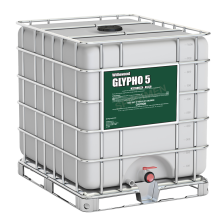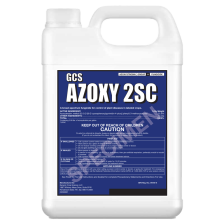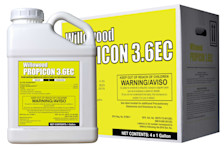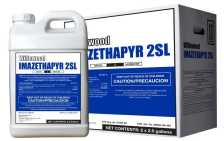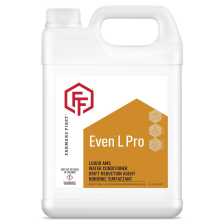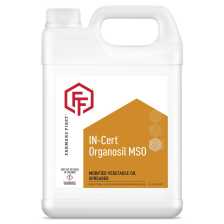Surfactants 101: Understanding the Extras in Your Tank Mix
This guide includes the following sections:
What Is a Surfactant?
Surfactants are a particular type of adjuvant used in agricultural production to enhance crop protection spray characteristics by increasing surface contact, reducing runoff, and improving leaf penetration. Adding a surfactant to the tank mix can improve the absorption, uptake, and efficacy of herbicide, insecticide, and fungicide active ingredients.
Learn 4 ways to minimize spray drift here.
Agriculture Surfactant Classifications
There are several types of surfactants commonly used in agriculture, including:
Non-ionic surfactants (NIS)
Anionic surfactants
Nitrogen-surfactant blends
Organosilicones
Oil-surfactant blends
Non-Ionic Surfactants (NIS)
Non-ionic surfactants are all-purpose adjuvants compatible with a wide range of pesticides, including herbicides, plant growth regulators, defoliants, fungicides, and insecticides. They help reduce the surface tension of a spray mix, improving its spreading and sticking ability on a leaf’s surface. Non-ionic surfactants can improve the wetting capability of pesticide sprays, increasing leaf coverage. Adequate coverage is critical to maximize the efficacy of contact pesticides, including some post-emergence herbicides and fungicides.
Non-ionic surfactants are generally one of the least expensive surfactants used in agricultural production. When used according to label instructions, they also pose less crop injury risk than other surfactant classes. Non-ionic surfactants are the most widely used surfactants in agriculture because they mix easily with most pesticides.
Non-ionic surfactants are recommended, and often required, with many pesticide active ingredients, including (not an all-inclusive list):
Glyphosate (herbicide)
Quizalofop p-ethyl (herbicide)
Fluazifop-p-butyl (herbicide)
Paraquat dichloride* (herbicide)
Clopyralid (herbicide)
Azoxystrobin (fungicide)
Propiconazole (fungicide)
Examples of non-ionic surfactants include:
Farmers First™ IN-Zorb™ 90 — A general-purpose non-ionic surfactant designed to improve the performance of pesticide sprays by modifying the wetting and spreading properties of droplets on the leaf or target surface.
Farmers First™ IN-Zorb™ ADV — An APE-free non-ionic surfactant designed to improve the effectiveness of crop protection products by reducing the surface tension of spray droplets for uniform spreading and coverage of leaf surfaces. The APE-free formulation is safe to use in late-season fungicide applications on corn, and it will not lead to arrested ear development.
Anionic Surfactants
Anionic surfactants form a negative ion when placed in water, enhancing a pesticide tank mix's foaming and spreading properties. They are often blended with non-ionic surfactants to improve a herbicide formulation's wetting and emulsifying properties. Anionic surfactants aren’t compatible with all pesticides and do not generally mix well with hard water.
Nitrogen-Surfactant Blends
Nitrogen-surfactant blends are commonly used with postemergence broadleaf herbicides to reduce surface tension and improve leaf surface spreading of a spray application. Typically, these products are a premix of some source of nitrogen fertilizer plus surfactants.
Nitrogen-surfactant blends can be used when a herbicide label recommends adding ammonium sulfate (AMS) or 28% nitrogen to the tank mix, and they can replace standard AMS products in the tank mix.
There are a couple of benefits of using ammonium salts in a herbicide tank mix.
They help reduce herbicide tie-up in hard water so more active ingredient is available for weed uptake.
When used as a spray additive, ammonium may improve the absorption of many weak acid postemergence herbicides by creating a favorable pH gradient across the cell membrane.
Nitrogen-surfactant blends are commonly used with the following postemergence broadleaf herbicide active ingredients (not an all-inclusive list):
Examples of nitrogen-surfactant blends include:
Even™ L Pro — A premix of drift management agents, AMS, deposition aids, and surfactant that reduces tie-up of herbicides in hard water, improves spray application coverage, and minimizes spray drift.
FBN AMS Pro — A 3-in-1 nitrogen-surfactant that includes a defoamer and drift agent.
Organosilicone Surfactants
Organosilicone surfactants are a newer class of surfactant that offer even more pesticide wetting, spreading, adhesion, and penetration power than conventional non-ionic surfactants. They are formulated as a blend of silicone and other surfactants. Organosilicone surfactants offer excellent rainfastness to improve pesticide uptake.
Organosilicone surfactants are a great option in high-weed pressure situations or when environmental conditions may limit effective weed control. They are commonly used with the following herbicide active ingredients (not an all-inclusive list):
Farmers First™ IN-Cert™ Organosil MSO is a multifunction organosilicone surfactant that rapidly penetrates leaf surfaces and provides superior surface coverage compared to ordinary silicone blends, methylated seed oil, or crop oil.
Oil-Surfactant Blends
Some crop oil concentrates and methylated seed oils (MSO) contain surfactants that work together with the cuticle-penetrating power of the oil to improve herbicide efficacy. High surfactant oil concentrates (HSOCs) generally contain at least 50% w/w oil plus 25 to 50% w/w surfactant. HSOCs enable lower use rates than standard crop oil concentrates.
Farmers First™ IN-Cert™ HighSurf MSO is a specialized blend of modified seed oil and surfactant designed to enhance the performance of herbicides. It may be used at reduced rates compared to conventional MSO. IN-Cert HighSurf MSO may also be used with insecticides, fungicides, and plant growth regulators (PGRs).
IN-Plant™ ADV is a hybrid adjuvant combining the functions of oil concentrate, nonionic surfactant, and penetrant in one product. It can replace high surfactant oil concentrates as well as crop oil concentrates.
What’s the difference between a crop oil concentration and a non-ionic surfactant? Find out here.
How Do Surfactants Work?
Most surfactants work by reducing the surface tension between the spray solution and the plant surface. The main goal of any surfactant is to improve a pesticide product’s efficacy. Depending on the surfactant, it does that by:
Increasing herbicide penetration through waxy leaf cuticles
Improving the spreading qualities of the spray
Keeping the leaf wet longer for more absorption
Improving the sticking characteristics to prevent runoff
When to Use a Surfactant for Agriculture Sprays
Surfactants can be a cost-effective way to improve the efficacy of insecticide, fungicide, and herbicide spray applications. Although they do not contain any active ingredients, they should be used whenever the pesticide label recommends them to improve spray characteristics.
Surfactants are especially beneficial for:
Spray applications where there is heavy pest pressure or large weeds
Contact herbicide and fungicide applications where coverage is critical
Spray applications during extreme conditions (hot, dry/wet, cool)
Choosing the Right Surfactant for a Spray Application
Surfactants are most commonly used with post-emergence herbicides, fungicides, and insecticides. Every surfactant offers different benefits, so it’s important to consult the pesticide label to ensure you choose the best option for each specific application.
When comparing surfactants for a herbicide application, keep these considerations top of mind:
The concentration and type of surfactant (ingredients)
Use rates
The target weeds (including size and pressure)
The environmental conditions
Product cost
In general, non-ionic surfactants are all-purpose products that are compatible with a wide variety of pesticides. Choose a nitrogen-surfactant blend if you’re applying a broadleaf, post-emergence herbicide like glyphosate or glufosinate. Organosilicone surfactants are a great option for herbicide applications in extreme conditions or where weed pressure is heavy. High surfactant oil concentrates work well when glyphosate is tank-mixed with an oil-loving herbicide like lactofen or fomesafen. For more information on adjuvant selection, see our Adjuvants Product Guide.
Buy Surfactants at FBN
Choosing an effective surfactant is a great way to improve the return on investment of many pesticide applications. FBN offers a complete portfolio of adjuvants, including non-ionic surfactants and AMS products, to meet your crop protection needs. With a user-friendly online platform, transparent pricing, and direct-to-farm delivery available on your schedule, FBN puts Farmers First®.
Related Resources
Acetochlor 101: Everything Farmers Need to Know About Acetochlor
Atrazine 101: Everything Farmers Need to Know About Atrazine
Bifenthrin 101: Everything Farmers Need to Know About Bifenthrin
Biostimulants 101: Everything Growers Need to Know About Biostimulants
Clopyralid 101: Everything Farmers Need to Know About Clopyralid
Clethodim 101: Everything Farmers Need to Know About Clethodim
Crop Nutrition 101: Everything Farmers Need to Know About Crop Nutrition
Fungicides 101: Everything Farmers Need to Know About Fungicides
Glyphosate 101: Everything Farmers Need to Know About Glyphosate
Glufosinate 101: Everything Farmers Need to Know About Glufosinate
Herbicides 101: Everything Growers Need to Know About Herbicides
Inoculants 101: Everything Farmers Need to Know About Inoculants
Insecticides 101: Everything Farmers Need to Know About Insecticides
Lambda-Cyhalothrin 101: Everything Farmers Need to Know About Lambda-Cy
Metolachlor: Everything Farmers Need to Know About Metolachlor
Nitrogen 101: Everything Farmers Need to Know About Nitrogen
Paraquat 101: Everything Farmers Need to Know About Paraquat
Copyright © 2014 - 2025 Farmer's Business Network, Inc. All rights Reserved. The sprout logo, “Farmers Business Network”, "Farmers First", “FBN”, “FBN Direct,” and “FieldGrip” are servicemarks, trademarks or registered trademarks of Farmer's Business Network, Inc.
All other trademarks are the property of their respective owners.
Willowood Paraquat 3SL is a restricted-use pesticide.
Willowood Imazethapyr 2SL is a restricted-use pesticide.
*Restricted Use Pesticides due to acute toxicity. For retail sale to and use by certified applicators only – NOT to be used by uncertified persons working under the supervision of a certified applicator.
FBN Direct products and services and other products distributed by FBN Direct are offered by FBN Inputs, LLC and are available only in states where FBN Inputs, LLC is licensed and where those products are registered for sale or use, if applicable. If applicable, please check with your local extension service to ensure registration status. Nothing contained on this page, including the prices listed should be construed as an offer for sale, or a sale of products. All products and prices are subject to change at any time and without notice. Terms and conditions apply.
ALWAYS READ AND FOLLOW LABEL DIRECTIONS. It is a violation of federal and state law to use any pesticide product other than in accordance with its label. The distribution, sale and use of an unregistered pesticide is a violation of federal and/or state law and is strictly prohibited. We do not guarantee the accuracy of any information provided on this page or which is provided by us in any form. It is your responsibility to confirm prior to purchase and use that a product is labeled for your specific purposes, including, but not limited to, your target crop or pest and its compatibility with other products in a tank mix and that the usage of a product is otherwise consistent with federal, state and local laws. We reserve the right to restrict sales on a geographic basis in our sole discretion. You must have a valid applicator license to use restricted use pesticides. Please consult your state department of agriculture for complete rules and regulations on the use of restricted use pesticides, as some products require specific record-keeping requirements.
The material provided is for educational purposes only. It is not intended to be a substitute for specific agronomic, business, legal, investment or professional advice. Where specific advice is necessary or appropriate, consult with a qualified agronomist, financial planner, or investment manager. Neither Farmer's Business Network, Inc. nor any of its affiliates makes any representations or warranties, express or implied, as to the accuracy or completeness of the statements or any information contained in the material and any liability therefore is expressly disclaimed.
